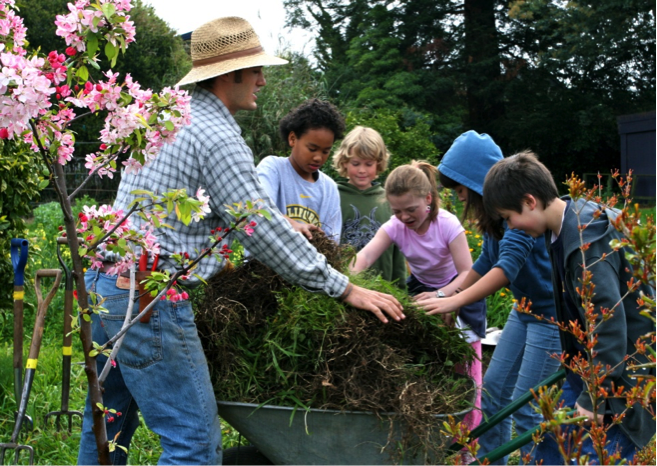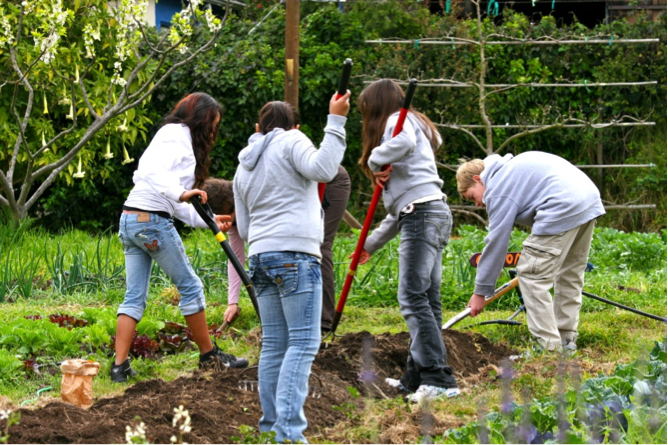Society is obsessed with food. From farmers’ markets and farm to table restaurants to celebrity chefs and cookbooks galore, it is clear that the United States loves to eat. But do we really know the story of our food? Food insecurity and food deserts are real concerns for communities across the country. Many children, especially in underserved and minority communities, do not know where their food comes from and how it is produced. Fortunately, programs like Nourish are opening students’ eyes to issues around food literacy and are challenging them to take action in their communities.
Background: Origin and Mission
Nourish is an educational initiative, launched in 2009, that is designed to open a meaningful conversation about food and sustainability, particularly in schools and communities. The initiative is a program of WorldLink (www.goworldlink.org), a nonprofit whose mission is to inspire understanding of critical global and local issues through transformative learning experiences. Through PBS television, curriculum resources, web content, short films, and teacher and youth seminars, Nourish is inspiring individuals across the United States, and the world, to celebrate and appreciate both food and community.
Nourish is the first national organization dedicated to promoting food literacy and using the issue as a catalyst for action. The initiative understands that the more a person knows about an issue, the more likely he or she will act to address it. Nourish uses systems thinking to enlarge context and spark inquiry. Students explore where food comes from, how it gets to us, and how food is affected by economic, social, and environmental factors. Nourish developed a rubric to measure food literacy across 20 indicators in three categories:
- Core Concepts: What does one understand about the larger food system?
- Values: What food system issues does one recognize and value?
- Practices: What is one’s repertoire of food-related practices?
The indicators in this rubric inspire the activities and discussion in Nourish’s interdisciplinary classroom curriculum.

Nourish Curriculum for Classrooms
The Nourish Curriculum Guide was developed in partnership with the Center for Ecoliteracy and contains seven learning activities teachers can use to engage students in discussion around food, community, and sustainability. Each activity revolves around a core question, and together they encourage students to reflect on current food systems, explore more sustainable food practices, and ultimately link their learning to relevant action. The seven learning activities include:
- The Story of Food: How does the way food is raised, processed, transported, and eaten impact both people and the environment?
- Seasonal, Local Foods: How does eating locally grown and seasonal food benefit the health of people and the environment?
- Food Traditions: What can we learn about our culture and one another through the foods we eat?
- Food and Ecosystems: In what ways do we depend on ecosystems for our food?
- Analyzing Food Ads: How do marketing techniques influence what we eat?
- School Lunch Survey: In what ways might we improve the food at our school?
- Nourish Action Projects: How can we take action to address food-related issues at home, at school, and in the community?
Nourish Action Projects, the service learning component of the curriculum, ties together the themes and issues discussed in the preceding learning activities and challenges students to identify a need in their community around food and sustainability; develop a plan to take action; and carry out their project or projects.
Results are in: Service-Learning Catalyzes Student Action
During 2012-2013, the California Department of Public Health commissioned an independent evaluation of Nourish. The research focused on low-income middle schools in Northern California and its results revealed important findings related to food literacy, as well as the role of service-learning in the Nourish curriculum. Some findings include:
- Students who participated in Nourish want to “help with the growing of fruits and/or vegetables, participate in organizations working on food issues, and understand how government policies affect food.”
- The Nourish initiative “is effective in facilitating actions related to sustainable food practices.”
- Students who experience Nourish programming “have the potential to serve as youth advocates and/or educators for sustainable food practices” and “could be change agents for healthy and sustainable food practices at the family level.”
- Nourish “has a positive influence on the perceptions, attitudes, and actions of the participants.”
Teachers who participated in Nourish reported that the curriculum increased students’ knowledge and understanding of how their food is connected to the world around them. One teacher in particular remarked on the service learning angle:
“The ultimate goal of Nourish is for students to participate in action projects that include teaching others, growing a school garden, meeting local farmers, and being proactive in making healthy food choices. In teaching others we enrich our immediate community, in growing the garden we enrich our school community, in meeting local farmers we enrich our local community, and in making good choices we can impact even larger communities!”

The value of Nourish is best summed up by this student:
“I learned that you can make a difference. Every person can make a small difference to the whole picture. I also learned that eating locally is better for the environment, the farmers, and for yourself—it’s a win-win.”
Nourish in Action: A School Success Story in California
In Big Bear, California, middle school teacher Tracy Tokunaga used the Nourish curriculum to create an elective class that gives her students a direct experience with the farm to table concept. In the first year of the program, the class hosted a Healthy Taste of Big Bear fundraising dinner and invited local restaurants to donate healthy, local food. The following year, Ms. Tokunaga’s Nourish class teamed up with the Farm2Mountain Produce Club, a farm-direct produce service, to enable seasonal, organic, and locally grown food to be delivered to the classroom and the surrounding community. Students manage the whole process: taking orders, sorting and packing produce, and distributing boxes of produce to the community. In addition, the Produce Club raises funds to support the Nourish class with organic fruit and vegetable tastings, field trip opportunities, and cooking classes.
Resources for the Classroom
Interested in using Nourish in your classroom? The Nourish website (http://www.nourishlife.org/) has a wealth of resources to help teachers create their own food literacy units, including:
- The Nourish Curriculum Guide: The curriculum includes a video, viewing guide, learning activities, a glossary, and suggested resources.
- Food System Tools: These info-graphics and activities help students visualize where our food comes from and how it gets to us.
- Videos and Perspectives: Learn from thought leaders and practitioners on the frontlines of food, health, and sustainability.
- Nourish in Action Stories: Read inspiring stories about schools that are using Nourish to transform their communities.
- Action Ideas: The Act section of the website suggests actions you can take to build a healthy, sustainable food culture.
